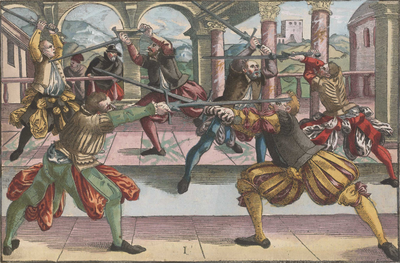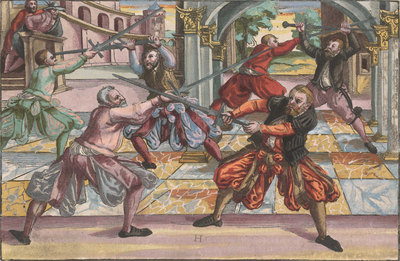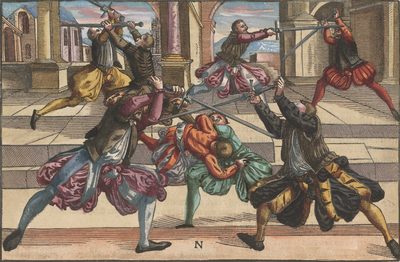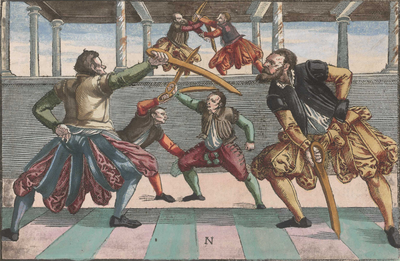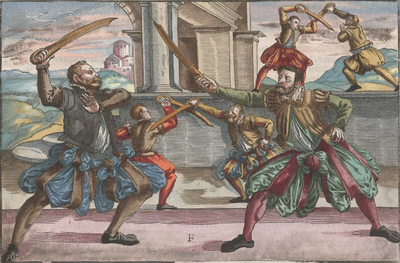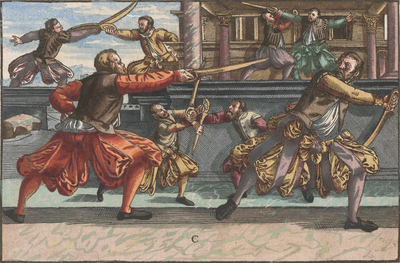|
|
You are not currently logged in. Are you accessing the unsecure (http) portal? Click here to switch to the secure portal. |
Difference between revisions of "Rosen"
Jump to navigation
Jump to search
m (2 revisions) |
|||
| (5 intermediate revisions by the same user not shown) | |||
| Line 1: | Line 1: | ||
| − | + | {{master begin | |
| + | | title = Joachim Meyer | ||
| + | | width = 100% | ||
| + | }} | ||
| + | {{master subsection begin | ||
| + | | title = Sword | ||
| + | | width = 90em | ||
| + | }} | ||
| + | {| class="master" | ||
| + | |- | ||
| + | ! <p>Images</p> | ||
| + | ! <p>{{rating|C|Draft Translation (from the 1570)}}<br/>by [[Mike Rasmusson]]</p> | ||
| + | ! <p>[[Gründtliche Beschreibung der Kunst des Fechtens (Joachim Meyer)|1570 Transcription]]{{edit index|Gründtliche Beschreibung der Kunst des Fechtens (Joachim Meÿer) 1570.pdf}}</p> | ||
| − | The | + | |- |
| + | | | ||
| + | | <p>'''Middle Guard'''</p> | ||
| + | |||
| + | <p>Concerning this Middle Guard you will be instructed later in the section on the dussack; as you do it there with one hand, so shall you do it here with both hands. I did not initially intend to present it here, but I have not been able to avoid it, since the Rose can be more fitly taught from no other guard. And note when an opponent comes before you who holds his sword extended before him in the Longpoint, or else in Straight Parrying, then send your blade in a circle around from the Middle Guard right around his blade, so that your blade comes almost back to your initial Middle Guard; from there swing the foible powerfully from outside over his arms at his head. Or when you have thus gone around his blade with the Rose, if he meanwhile should fall in down from above to your opening, then take his blade out with the short edge, that is when you have come for the second time in the Middle Guard; for he will not come so quickly as if by surprise to your opening, but that you will meanwhile come around with the Rose, such that you will come to take him out in plenty of time. And after you have thus taken him out, then let your weapon run around in the air over your head (in order to deceive him), looping for a Circle to the next opening, etc.</p> | ||
| + | |||
| + | | {{section|Page:Gründtliche Beschreibung der Kunst des Fechtens (Joachim Meÿer) 1570.pdf/101|1|lbl=1.40va}} | ||
| + | |||
| + | |- | ||
| + | | | ||
| + | | <p>Or in the Onset when you have cut into the Middle Guard on your left, and meanwhile your opponent cuts at you from above, then step well out from his cut toward his right side, and cast your short edge over or outside his right arm at his head; and as you cast in, let your blade shoot well in, either at his head or over his arms. Afterwards pull your sword quickly back up, and cut from your left with the long edge strongly upward at his right arm. From there, attack him further as you will, with such techniques as you will find above or below in this treatise. And since the Rose can also fitly be executed in the Longpoint, I will describe the rest of the devices that I intended to present with the Longpoint, thus:</p> | ||
| + | | {{section|Page:Gründtliche Beschreibung der Kunst des Fechtens (Joachim Meÿer) 1570.pdf/101|2|lbl=1.40vb}} | ||
| + | |||
| + | |- | ||
| + | | | ||
| + | | <p>'''Longpoint'''</p> | ||
| + | |||
| + | <p>The combat masters of old called Longpoint the ‘Break-Window’, because all other devices can be broken from it. Now although one can sufficiently deduce from the devices I have already taught what one shall execute from this posture, based on similar ones, I will show something about it through examples, since the Longpoint is the end of all binding.</p> | ||
| + | | {{section|Page:Gründtliche Beschreibung der Kunst des Fechtens (Joachim Meÿer) 1570.pdf/102|1|lbl=1.41ra}} | ||
| + | |||
| + | |- | ||
| + | | [[File:Meyer 1570 Longsword I.jpg|center|400px]] | ||
| + | | <p>In the Onset, bind on your opponent’s sword with the High Cut, and as soon as he goes back up again from your sword, then cut at his chin from below between his arms while they are going up. Concerning this device see the two small figures on the upper left in Image I.</p> | ||
| + | | {{section|Page:Gründtliche Beschreibung der Kunst des Fechtens (Joachim Meÿer) 1570.pdf/102|2|lbl=1.41rb}} | ||
| + | |||
| + | |- | ||
| + | | | ||
| + | | <p>Item: bind him as before, and as soon as the swords connect in the bind, then break through below with the Rose between you and him, and cast the short edge in at his head on the other side. Or after you have broken through below from the bind with the Rose, then wrench his sword sideways from the other side with the short edge, so that your hands cross over one another in the air; strike deep with the short edge over at his head.</p> | ||
| + | | {{section|Page:Gründtliche Beschreibung der Kunst des Fechtens (Joachim Meÿer) 1570.pdf/102|3|lbl=1.41rc}} | ||
| + | |||
| + | |- | ||
| + | | | ||
| + | | <p>Item: bind him against his incoming cut, and as soon as the blades connect, push your pommel through under your right arm, stepping at the same time well out toward his left side; and go up with crossed hands, and cut with the long edge through the Rose sideways from below behind his arm at his head.</p> | ||
| + | | {{section|Page:Gründtliche Beschreibung der Kunst des Fechtens (Joachim Meÿer) 1570.pdf/102|4|lbl=1.41rd}} | ||
| + | |||
| + | |- | ||
| + | | [[File:Meyer 1570 Longsword H.jpg|center|400px]] | ||
| + | | <p>Item: when you bind your opponent, then release your left hand from the pommel, and use it to grip his blade to yours in the bind, and do it quickly; then go through below with your right hand and the haft, and strike up toward your right, as you can see in the two small figures on the right in Image H; thus you take his sword away from him.</p> | ||
| + | | {{section|Page:Gründtliche Beschreibung der Kunst des Fechtens (Joachim Meÿer) 1570.pdf/102|5|lbl=1.41re}} | ||
| + | |||
| + | |- | ||
| + | | | ||
| + | | <p>Item: if your opponent binds you with extended sword on yours, then note when the binds connect together, and quickly change through below, and flick the little flat of the foible at his ear from the other side. From this changing through you will learn to do many fine devices, if you diligently study it.</p> | ||
| + | | {{section|Page:Gründtliche Beschreibung der Kunst des Fechtens (Joachim Meÿer) 1570.pdf/104|1|lbl=1.42ra}} | ||
| + | |||
| + | |- | ||
| + | | [[File:Meyer 1570 Longsword N.jpg|center|400px]] | ||
| + | | <p>Item: when you see that your opponent will bind or cut at you, then send your sword in against him, as if you also intended to bind, and just when the blades are about to connect, push your pommel up quickly, and turn your blade up from below through the Rose, catching his stroke on your long edge, as is shown in the small scene on the right in Image N. After you have thus caught his cut, you can finish this device in two ways. Firstly thus: when the swords have connected, then go right through below with your blade, and wrench his blade toward your right, and let your hands snap around in the air again, or cross over one another, and cut with the short edge strongly at his head. This is a masterful going through that will not fail you, if he should cut from above. For the second, when you have caught his sword, then as the swords clash together, step well to his left side, and cut back with the long edge from outside over his left arm at his head. This last cut proceeds unexpectedly, very swiftly, surely, and strongly.</p> | ||
| + | | {{section|Page:Gründtliche Beschreibung der Kunst des Fechtens (Joachim Meÿer) 1570.pdf/104|2|lbl=1.42rb}} | ||
| + | |||
| + | |} | ||
| + | {{master subsection end}} | ||
| + | |||
| + | {{master subsection begin | ||
| + | | title = Dussack | ||
| + | | width = 90em | ||
| + | }} | ||
| + | {| class="master" | ||
| + | |- | ||
| + | ! <p>Images</p> | ||
| + | ! <p>{{rating|C|Draft Translation (from the 1570)}}<br/>by [[Mike Rasmusson]]</p> | ||
| + | ! <p>[[Gründtliche Beschreibung der Kunst des Fechtens (Joachim Meyer)|1570 Transcription]]{{edit index|Gründtliche Beschreibung der Kunst des Fechtens (Joachim Meÿer) 1570.pdf}}</p> | ||
| + | |||
| + | |- | ||
| + | | | ||
| + | | <p>Now some cuts are not reversed in delivering them, and yet are named differently, and the reasons are these. The first is according to the intention of the one who delivers it, as happens with the Failing and Knocking Cut, which although they are High Cuts, yet they are so named because my intent is to miss with the one, with the other to knock against my opponent if I have an opening. And some names are based on the emotion of the mind, like the Wrath and Anger Cut. Also some receive their names from the shape they resemble in cutting, like the Rose Cut. Some are named for the limb at which they are delivered, as you will see in the section on the rapier in the Hand Cut and the like. On the basis of what I have now presented, you can now easily understand the cuts that are presented afterwards, and observe how much they are distinct from the chief cuts.</p> | ||
| + | | {{section|Page:Gründtliche Beschreibung der Kunst des Fechtens (Joachim Meÿer) 1570.pdf/168|1|lbl=2.9ra}} | ||
| + | |||
| + | |- | ||
| + | | [[File:Meyer 1570 Messer N.jpg|center|400px]] | ||
| + | | <p>'''Rose Cut'''</p> | ||
| + | |||
| + | <p>If you find an opponent waiting in the Bow, then act as if you intended to cut from above at his head; do not let the cut connect, but go outside his right arm and through below, so that you come around in a circle around his dusack, and let it run off again in the air beside his right, and cut at his face. You may go around his parrying this way on the other side in a circle, and cut in where you find him open.</p> | ||
| + | | {{section|Page:Gründtliche Beschreibung der Kunst des Fechtens (Joachim Meÿer) 1570.pdf/172|3|lbl=2.11ra}} | ||
| + | |||
| + | |||
| + | |- | ||
| + | | [[File:Meyer 1570 Messer F.jpg|center|400px]] | ||
| + | | <p>'''The Straight Parrying or Slice'''</p> | ||
| + | |||
| + | <p>Chapter 11</p> | ||
| + | |||
| + | <p>In this parrying, position yourself thus: stand with your right foot forward and hold your dusack in front of you with your arm extended, so that your long edge stands toward the opponent and the tip of your weapon is forward, as shown by the large figure on the right in the adjoining image. I consider this posture the best of all, because you can wait for your opponent in this position more safely than in any other.</p> | ||
| + | | {{section|Page:Gründtliche Beschreibung der Kunst des Fechtens (Joachim Meÿer) 1570.pdf/215|2|lbl=2.32v}} | ||
| + | |||
| + | |- | ||
| + | | | ||
| + | | <p>'''A Swift Deceitful Device to execute against this Straight Parrying '''</p> | ||
| + | |||
| + | <p>Note when you find your opponent in Straight Parrying, then position yourself in the Onset in the Wrath Guard or Steer, and send a high stroke with earnest comportment from your right shoulder at his face. Yet do not let it hit, but just as the cut should connect above, go below with your dusack and toward his left right around his dusack in a circle through the Rose, so that your dusack comes under his right arm and out toward your<ref>read: his?</ref> left up in the air. Then quickly let it run off twice in the air, once against his left, the second time against his right, and deliver a Middle Cut through from your right at his face. For all this you shall have two steps forward, the one for the first Wrath Cut, with which you will not hit but go around beside him without hitting, the second for the double running off and the Middle Cut; for when you bring your dusack in the air for the running off, you shall at the same time lift up your right foot, and execute the double running off so quickly that you hit with the Middle Cut just as you set your foot back down again.</p> | ||
| + | | {{section|Page:Gründtliche Beschreibung der Kunst des Fechtens (Joachim Meÿer) 1570.pdf/220|3|lbl=2.35r}} | ||
| + | |||
| + | |- | ||
| + | | | ||
| + | | <p>This is a fluid and swift device and proceeds well, if you first learn to do it well. As soon as the Horizontal Cut has hit, then strike back across from below to his right arm with good parrying. When you hit with this cut, then note whether he is high or low with his arm: if he is high, then turn your point under his arm with a thrust at his chest or hip; but if he is low, then turn your point above his arm at his face, palm away from him, so that your long edge stands upward in the thrust. One of these two thrusts will be most suitable for you, either palm toward or away from him. Then follow up this thrust powerfully and quickly with a cut, namely the High Thrust with a Low Cut through his right, the Low Thrust with a High Cut through his left.</p> | ||
| + | | {{section|Page:Gründtliche Beschreibung der Kunst des Fechtens (Joachim Meÿer) 1570.pdf/220|4|lbl=-|p=1}} {{section|Page:Gründtliche Beschreibung der Kunst des Fechtens (Joachim Meÿer) 1570.pdf/221|1|lbl=2.35v|p=1}} | ||
| + | |||
| + | |- | ||
| + | | [[File:Meyer 1570 Messer C.jpg|center|400px]] | ||
| + | | <p>'''Concerning the Middle Guard and How One''' Shall Fight from It</p> | ||
| + | |||
| + | <p>Chapter 14</p> | ||
| + | |||
| + | <p>I call this the Middle Guard because it arises from the Middle Cut. Now you can come into this guard at the end of three cuts: first when you strike a Crooked Cut from your right through the Wrath Line, and let it swing beside your left right back into the Middle Guard; then through the Middle Cut itself; thirdly when you strike a Crooked Cut from below through the upward diagonal line from your right toward your left. These three cuts always swing most readily to the Middle Guard, even if you try to pull them to another.</p> | ||
| + | | {{section|Page:Gründtliche Beschreibung der Kunst des Fechtens (Joachim Meÿer) 1570.pdf/236|2|lbl=2.43r}} | ||
| + | |||
| + | |- | ||
| + | | | ||
| + | | <p>Position yourself for it as shown by the figure on the right in this image. From this guard you can execute all the devices that are taught in the left Wrath and Steer; therefore I will only briefly recount a few devices, from which you will sufficiently learn the use of this guard.</p> | ||
| + | | {{section|Page:Gründtliche Beschreibung der Kunst des Fechtens (Joachim Meÿer) 1570.pdf/236|3|lbl=-}} | ||
| + | |||
| + | |- | ||
| + | | | ||
| + | | <p>'''How you shall flick from this guard outside at his right arm'''<br/><br/></p> | ||
| + | |||
| + | <p>Another: if an opponent encounters you in the Bow or in Straight Parrying, then position yourself in the Middle Guard; from there strike outside at his right arm with the outside flat in a flick. Quickly pull your hilt up, so that in this pulling up, your blade hangs down, and with this, jerk your dusack around your head. Then cut through with the crooked edge from below inside at his right arm with a step forward on your right foot, so that at the end of the cut your dusack comes [2.45v] into the left Wrath Guard. From there cut powerfully from below through his face; then quickly cut after with the Cross.</p> | ||
| + | |||
| + | <p>Also you can attack from this guard using the Rose, with Flicking Cuts and other deceits. For the Rose Cuts go particularly well with a deceit from this Middle Guard, thus:</p> | ||
| + | |||
| + | <p>If you find an opponent in the Bow who is smaller than you, then send your outside flat from your right above his hilt toward his right, outside his right arm, and in a single motion under his dusack back up toward your right. Let it fly back around above your head in the air, with your foot raised, and strike him with hanging dusack and inside flat in a flick outside to his right arm. Then pull upward, and cut the Roarer across through the Middle Line, as you have learned previously in the section on the cuts. And this must take place in a single motion, so that in the beginning of the motion you lift your right foot, and as the Roarer hits, you set it back down with a step forward.</p> | ||
| + | | | ||
| + | {{section|Page:Gründtliche Beschreibung der Kunst des Fechtens (Joachim Meÿer) 1570.pdf/240|4|lbl=2.45r|p=1}} {{section|Page:Gründtliche Beschreibung der Kunst des Fechtens (Joachim Meÿer) 1570.pdf/241|1|lbl=2.45v|p=1}} | ||
| + | |||
| + | |} | ||
| + | {{master subsection end}} | ||
| + | |||
| + | {{master subsection begin | ||
| + | | title = Rapier | ||
| + | | width = 90em | ||
| + | }} | ||
| + | {| class="master" | ||
| + | |- | ||
| + | ! <p>Images</p> | ||
| + | ! <p>{{rating|C|Draft Translation (from the 1570)}}<br/>by [[Mike Rasmusson]]</p> | ||
| + | ! <p>[[Gründtliche Beschreibung der Kunst des Fechtens (Joachim Meyer)|1570 Transcription]]{{edit index|Gründtliche Beschreibung der Kunst des Fechtens (Joachim Meÿer) 1570.pdf}}</p> | ||
| + | |||
| + | |- | ||
| + | | | ||
| + | | <p>'''Deceitful Thrust'''</p> | ||
| + | |||
| + | <p>In the Onset, send a powerful thrust from the right High Guard of the Ox at his face; but as you thrust in, turn your thrust up from below with a broad step forward on your foot, and thrust under his hilt up at his belly. When you correctly reverse this High Thrust into a Low Thrust through the Rose, then it seems at first as if you were thrusting from above, then before he realises it, you have hit below.</p> | ||
| + | |||
| + | <p>Item: if your opponent stands before you in the Irongate, then thrust inside his weapon up at his face without hitting, so that your blade snaps around again toward your right and into the right Ox. Act as if you intended to thrust at him outside over his right arm; but deceitfully change your thrust in the air, and thrust at him from above under his weapon inside at his face.</p> | ||
| + | | {{section|Page:Gründtliche Beschreibung der Kunst des Fechtens (Joachim Meÿer) 1570.pdf/278|3|lbl=2.64r}} | ||
| + | |||
| + | |} | ||
| + | {{master subsection end}} | ||
| + | |||
| + | {{master subsection begin | ||
| + | | title = Staff | ||
| + | | width = 90em | ||
| + | }} | ||
| + | {| class="master" | ||
| + | |- | ||
| + | ! <p>Images</p> | ||
| + | ! <p>{{rating|C|Draft Translation (from the 1570)}}<br/>by [[Mike Rasmusson]]</p> | ||
| + | ! <p>[[Gründtliche Beschreibung der Kunst des Fechtens (Joachim Meyer)|1570 Transcription]]{{edit index|Gründtliche Beschreibung der Kunst des Fechtens (Joachim Meÿer) 1570.pdf}}</p> | ||
| + | |||
| + | |- | ||
| + | | | ||
| + | | <p>'''Low Guard'''</p> | ||
| + | |||
| + | <p>Do it thus: stand with your left foot forward again, hold your staff with the butt on your flank, and with the tip extended before you on the ground. If you hold the butt on your right flank, then it doesn't matter whether you hold or send the tip extended to the left or right or straight before you: you can vary how you extend it, either according to how he attacks, or according to what techniques you intend to use.</p> | ||
| + | | {{section|Page:Gründtliche Beschreibung der Kunst des Fechtens (Joachim Meÿer) 1570.pdf/397|2|lbl=3.16v}} | ||
| + | |||
| + | |- | ||
| + | | | ||
| + | | <p>'''How you shall take him out upward with the long edge from your left,''' and thrust through the Rose back up from below from your right at his face</p> | ||
| + | |||
| + | <p>In the Onset, position yourself in the Low Guard on the left as before; if he thrusts in at you, then go up with both arms, and strike out his thrust with the foible of your staff up from your left toward your right with the long edge, so that in striking him out your staff comes right up through; then turn your staff back by your right side up from below, and thrust from that side back up at his face.</p> | ||
| + | | {{section|Page:Gründtliche Beschreibung der Kunst des Fechtens (Joachim Meÿer) 1570.pdf/405|2|lbl=3.20v}} | ||
| + | |||
| + | |} | ||
| + | {{master subsection end}} | ||
| + | {{master end}} | ||
| + | |||
| + | ==References == | ||
| + | |||
| + | {{reflist}} | ||
[[Category:Other Techniques]][[Category:German Techniques]] | [[Category:Other Techniques]][[Category:German Techniques]] | ||

